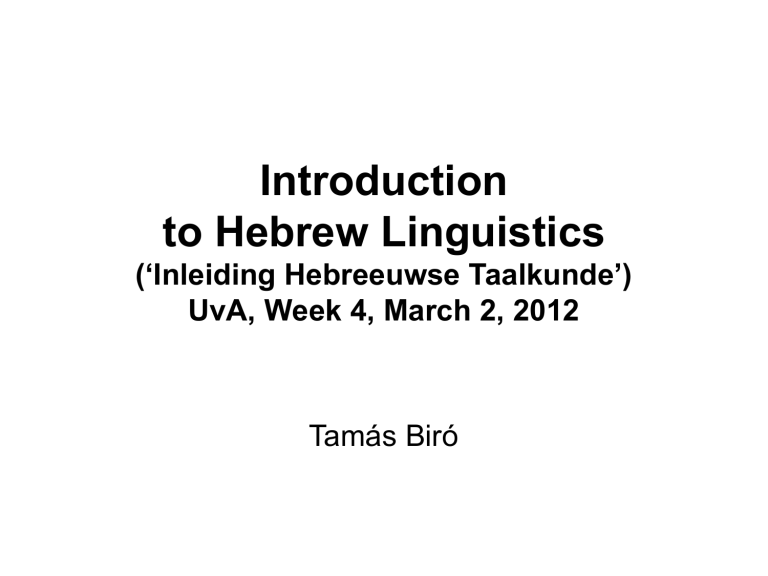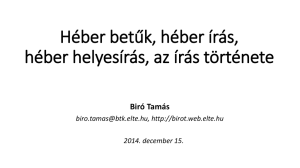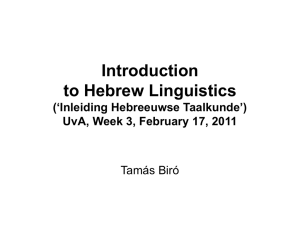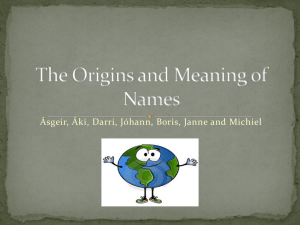ppt

Introduction to Hebrew Linguistics
(‘Inleiding Hebreeuwse Taalkunde’)
UvA, Week 4, March 2, 2012
Tamás Biró
Assignment for this week
1.
Arie Schippers en Kees Versteegh. Het Arabisch: Norm en realiteit. Coutinho 1987. Pp. 11-27 (semitische talen, schrift)
2.
John Huehnergard: ‘Introduction’. In: John Kaltner and Steven
L. McKenzie (eds.): Beyond Babel: A Handbook for BH and
Related Languages. SBL 2002. Pp. 1-18.
Assignment: Find contradictions between the two articles.
My goals have been:
(1) Make sure you read carefully and learn the chapters.
(2) Teach you to read critically: not to necessarily accept everything, since other opinions are also possible.
(3) Show that many opinions can be simultaneously around in science.
2
Assignment for this week
Arie Schippers en Kees Versteegh. Het Arabisch: Norm en realiteit.
Coutinho 1987. Pp. 11-27 (semitische talen, schrift)
John Huehnergard: ‘Introduction’. In: John Kaltner and Steven L.
McKenzie (eds.): Beyond Babel: A Handbook for BH and
Related Languages. SBL 2002. Pp. 1-18.
3
Hebrew: prehistory and four periods
0. Proto-Semitic, proto-NW-Semitic, proto-Canaanite, and proto-Hbrw: “The family tree: ancestors and relatives.”
1. Biblical Hebrew: “Did King David speak like the Bible?”
Pre-classical BH, classical BH, post-exilic BH; Qumran
Masoretic Hebrew = Tiberian Hebrew
2. Mishnaic/Rabbinic Hbrw: “A spoken language written”.
3. Medieval Hebrew: “Dead or alive?”
4. Modern Hebrew, Israeli Hebrew (Israeli language)
Haskala, language revival, contemporary IH
“Is it obvious that Hebrew is the language of Israel?”
4
History of the alphabet
From pictograms to a writing system
Source: Joseph Naveh. Early History of the Alphabet. Magnes Press, 1987.
6
From pictograms to cuneiform and hieroglyphs
Logograms denote whole word.
Disambiguation:
Phonetic complements : show last sounds of word.
Determinatives : denote word class.
Syllabograms
-Egyptian: also uniconsonantal signs.
Source: Joseph Naveh.
Early History of the Alphabet. Magnes
Press, 1987.
7
Alphabet: the principle of acrophony
• Egyptian uniconsonantal signs.
• West-Semitic alphabet: consonantal writing .
• Proto-Canaanite script
– cca. 1800 BCE: Wadi el-Hol??
– 17-16 th c BCE: Gezer,
Nablus (Shechem), Lachish
– approx. 1500 BCE:
Proto-Sinaitic inscriptions
(discovered by F. Petrie, 1905/06,
West Semitic slaves in turquoise mines?)
West-Semitic consonantal writings based on the principle of acrophony
• West-Semitic alphabet: strongly influenced by
Egyptian uniconsonantal signs?
• Ugaritic script:
– Akkadian (language & script) was also used in Ugarit.
– Developed alphabet (27C + 3V), but based on cuneiform:
– Abecedary from Ugarit: order had ritual importance?
Adopting a writing system to another language
• Cuneiform: Sumerian => Akkadian => Ugaritic, Luwian, Hittite,
Elamite, Persian, Tel el-Amarna glosses
• Hieroglyphic: Egyptian => Luwian, etc.
• Phoenician => Greek => Latin => English, Dutch, French,
Maltese
(= an Arabic dialect influenced by English and Italian) etc.
• Hebrew => Judeo-languages
• Arabic => Persian, Turkish. Cyrillic, etc. to many languages
Problems arising:
• Different phonological system: new sounds not present in the source language. Dutch: ch, sj… Hebrew: shin/sin (ayin/rayin?)
• Traditions borrowed together with the writing system that do not make sense in the new language: Hebrew spelling in
Yiddish, Sumerian logograms in Akkadian.
Further history of the Alphabet
End of 2 nd millennium: reduction of the number of letters.
South-Arabian => Ethiopian
Phoenician, developed into:
- Punic
- Greek => Latin,Coptic, Cyrillic…
- Paleo-Hebrew => Samaritan
- Aramaic =>
- Jewish
- Syriac
- Nabataean, Palmyrene => Arabic; India, Central Asia
Jewish scripts
• After Babylonian exile (587-539).
• Qumran, First Jewish War (6670), Bar Kokhba’s revolt
(132-135): sporadic use of paleo-Hebrew script (as an identity marker, a national symbol?).
• Paleography: very different handwriting styles in medieval manuscripts (Italian, Yemenite, etc. etc. etc.)
• Ashkenazi cursive (hand writing) => Israeli cursive.
• Sephardic cursive (hand writing): also used for Ladino.
– “Rashi” script: 16 th c., developed from Sephardic cursive to differentiate between Bible text and commentary.
• 1920s: Hebrew stenography. 1936: Hebrew Braille (both left-to-right)
Signs for each letter in Israeli Sign Language (ISL).
Early Hebrew epigraphy
Important inscriptions from the first temple period
First temple period
First temple period: 10 th century – 586 BCE
Epigraphy = study of inscriptions.
Found in archaeological excavations.
Using pre-exilic Hebrew script.
r http://en.wikipedia.org/wiki/Gezer_calenda
Some famous examples given below.
Recommended, even if not up-to-date introduction: Joseph
Naveh.
Early History of the Alphabet . Magnes Press,
1987. (Many copies at http://permalink.opc.uva.nl/item/002771446 )
14
The Gezer calendar
End of 10 th century BCE
School children learning agriculture?
“Two months gathering
Two months planting
Two months late sowing
One month cutting flax
[September-October]
[November-December]
[January-February]
[March] r
One month reaping and measuring (grain) [May]
Two months pruning [June-July]
One month summer fruit
Abijah”
[August]
Source of image: http://www.truthnet.org/Bible-Origins/4_How_was_Bible_written/Gezer_Calendar_Hebrew.jpg
15
The Mesha stele
9 th century
Moabite king’s victory over house of David.
In Moabite language: too similar to Biblical
Hebrew? Was it a general literary style?
r http://en.wikipedia.org/wiki/Gezer_calenda
Shape of letters: first distinctive features of
Hebrew writing.
Read text on: http://en.wikipedia.org/wiki/Mesha_stele .
Source of images: http://issachar5.files.wordpress.com/2010/05/mesha-stele.jpg
, http://www.houseofdavid.ca/bd_mesha.jpg
, http://vadym.web.cern.ch/vadym/images/MeshaSteleInscrip10cmh.gif
16
The Siloam (Shiloah) Inscription
2Chron. 32: King Hezekiah building a tunnel at the Gihon Spring , before the siege of
Jerusalem by the Assyrians in 701 BCE.
Happiness when those digging the tunnel from the two ends finally meet in the middle.
r http://en.wikipedia.org/wiki/Gezer_calenda
17
Seals
r http://en.wikipedia.org/wiki/Gezer_calenda
18
Jar handles:
la-melekh inscriptions r http://en.wikipedia.org/wiki/Gezer_calenda
19
Ostraca
Ostracon: letter (or else) written (with ink, sometimes incised) on a piece of pottery (typically broken off http://en.wikipedia.org/wiki/Gezer_calenda
Famous ones in Biblical archeology: Khirbet Qeiyafa
(1000 BCE?), Samaria (8 th c.), Mesad Hashavyahu
(late 7 th
(early 6 th c.: petition to the local governor), Arad c.), Lachish (early 6 th c.)...
20
Ostraca
r http://en.wikipedia.org/wiki/Gezer_calenda
21
Overview:
Development of the
Paleo-Hebrew script:
1. Gezer calendar: 10 th c.
2. Mesha stele: 9 th c.
3. Siloam inscription: late 8 th c.
4. Seals from the 7 th cent.
http://en.wikipedia.org/wiki/Gezer_calenda
5. Arad ostraca: early 6 th c.
6. Leviticus fragment:
2 nd c. BCE.
7. Medieval Samaritan bookhand.
Upper box: alef to kaf, lower box: lamed to tav.
22
Name of the Hebrew letters
• Name of the Hebrew letters come from the
Phoenician alphabet.
• Nice examples of sound changes:
– Phoenician rēš ~ Hebrew rōš , but cf. bərēšīt (Proto-
Semitic *rāš, cf. Arabic rās ).
– Phoenician bēt ~ Hebrew bayit , status constructus
(smichut) bēt . Probably, Proto-NWSemitic * bayt with a diphthong [ay]. It got monophthongized [ay] > [ ē ] in
Phoenician and in the Hebrew status constructus. But in the status absolutus of Hebrew, a second vowel [i] got inserted, [y] became a full vowel, and so the diphthong was eliminated by turning the word into two syllables.
A few words on orthography
Spelling
(Werner Weinberg: The History of Hebrew Plene Spelling, HUCP 1985, pp. 1ff)
:
Initially (10 th c. BCE, Gezer and Phoenician inscriptions): extremely defective/chaser :
– תב(for תיב),
– ז(for הז),
– נפל(for ינפל),
– מרעש(for םירועש, ‘barley+plural’)
Insertion of matres lectionis at the beginning of the words (more plene/male writing, cf. Mesha):
– יכ[ki], יתנב[baniti]
– הנב[bana] and [b'no], cf. הפ, הכ, המלש
24
A few words on orthography
Phonological change (monophthongization): diphthongs turned into monophthongs: [iy] > [i:], [uw] > [u:], [ay] >[e:], [aw] >[o:], [a?] >[a:].
Hence, letters originally denoting consonants/glides, now denote vowels.
Hence, the idea of vowel letters:
– Crucial in non-semitic languages (Greek borrowing the http://en.wikipedia.org/wiki/Gezer_calenda
Phoenician alphabet; Persian borrowing the Arabic r alphabet; Yiddish and Ladino...)
Biblical Hebrew: matres lectionis sometimes with and sometimes without etymological history.
Late Biblical Hebrew: more plene than classical BH.
Qumran Hebrew: extremely plene spelling.
25
A few words on orthography
Israeli Hebrew: rules of the Academy of the Hebrew Language:
– When to use matres lectionis in non-vocalized text
(e.g., yod in open syllables, but not in closed ones).
– How to transcribe foreign words: e.g. t vs. th, such as in ןופלטvs. הירואת.
– The writing system is not part of the language system !
Many languages have no writing system. Some have more wr systems.
– Orthography is not part of grammar !
Orthography = social convention, changing independently of lg.
Yet, traditional spelling can help reconstruct past stages the languages.
– Do not confuse sound with letter !
26
Reading for next week
1. Read: Ch. Rabin, Chapter 4, pp. 25-37.
2. Read the following two articles on translating the Hebrew Bible to Modern Hebrew / a.k.a. Israeli:
Ghil'ad Zuckermann: http://www.jpost.com/Home/Article.aspx?id=142577 reaction by Shira Leibowitz Schmidt: http://www.jpost.com/Opinion/Op-EdContributors/Article.aspx?id=142578
What is your opinion?
27
Assignment
Visit the Etruscan exhibition in the Allard Pierson Museum (free entrance with UvA student card). You will find a few objects that contain Etruscan inscriptions. These will be usually transcribed on the explanatory cards next to the object. Comparing to Latin and
Greek, what is you impression about the Etruscan script and language? Can you decode the letters? Some (not much) information about their language and writing system is given in the introduction to the exhibition.
Assignment: Describe your observations and subjective impressions about these Etruscan inscriptions in a few sentences.
At most 1 page. Email by Thursday noon to: t.s.biro@uva.nl.
28









